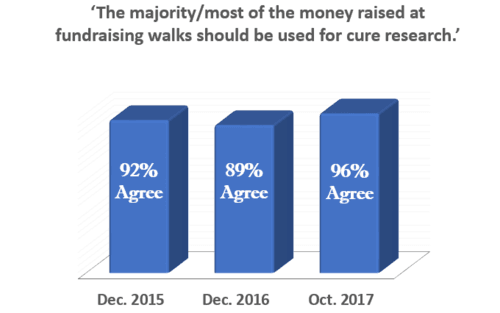
Based on a recent JDCA survey of the T1D community, the primary reason—by far—that people participate in diabetes fundraising walks is to fund cure research. This finding is the same as prior years, as shown in the chart above. There is no ambiguity that walk participants want the money they raise to be used for cure research.
The primary purpose of the survey was to ask the T1D audience why they participate in diabetes fundraising walks. All of the 203 survey respondents have participated in JDRF or ADA fundraising walks in the United States. Results are shared below:
Walkers Want All or Most of Walk Proceeds Used for Cure Research
The survey asked two key questions to understand how walkers want and expect the money raised at fundraising events to be used. The first question asked if the majority of money raised should be used for cure research while the second question asked if 100% of the money raised should be used for cure research. As illustrated below, responses leave little room for interpretation.
- 96% of walkers surveyed said that they want the majority of funds raised at walks to be used for cure research. This expectation is nearly unanimous.
- 72% of walkers surveyed said 100% of the money raised at fundraising walks should be used for cure research. Said differently, 3/4 of all walkers want ALL of the walk proceeds to be used for cure research.
Only a Minority of the Money Raised by T1D Walks is Actually Used for Cure Research
Donor fundraising events are the primary source of funding for the ADA and JDRF. Nearly 3/4 of JDRF annual income ($197m in 2016) and 1/3 of ADA annual income ($171m in 2016) is raised during fundraising events.
Given the survey results, it is no surprise that the main marketing and advertising messages used to encourage people to walk is a promise that the proceeds will be used to help find a cure. Any other message would likely yield less fundraising. During 2016, 98% of JDRF and 86% of ADA advertising promised to use the money generated from fundraising events to find a cure for T1D. Consequently, donors expect that the funding will be used for cure research.
Yet, actual research spending remains far lower than the advertising would imply. Only 38% ($75m) of JDRF 2016 income and only 3% ($5m) of ADA income was used to fund T1D research of any kind, including prevention, treatment, and cure research. More concerning, cure research is even less. JDRF spent only 7% of their total income on cure specific research and the ADA spent less than 1%. This information is publicly available in financial records.
Many Donors May Stop Giving
One of the most concerning findings from the survey is that 62% of donors say that they are less likely to participate in future fundraising walks once they learn how little of the walk proceeds are actually used to fund cure research.
- 12% of walkers surveyed said they will stop participating.
- 50% of walkers surveyed said they are less likely to participate in the future.
The message for the major T1D charities is clear. If they do not actively adjust research and cure research spending to directly align with donor priorities, future fundraising may be at risk—an outcome that is not good for anyone.
Donors Want Input Into How Their Fundraising Proceeds Are Used
88% of walkers surveyed said that the ADA and JDRF should seek direct input when making research funding decisions. Yet, donors are not represented in any meaningful way in the budget spending decisions at either organization.
This was not always the case. For many years, JDRF was a leader in incorporating the donor voice into research funding decisions via the donor advisory council. However, during the early 2000s, the council was eliminated and all research funding decisions were consolidated within the executives and board members. There has been no public announcement explaining this decision. As of today, there is no official mechanism for the average donor to directly influence research funding strategy and decision making.
Opportunity Cost of Lack of Alignment is Over $300 Million
The JDCA shares the data in this report with the hope that transparency will help to align donor wishes with the actions of the major T1D non-profits.
The dollar cost of this lack of alignment is striking. If JDRF had followed donor's unanimous wish to invest the majority (I.e. 51%) of fundraising proceeds into cure research over the past 5 years, the result would have been an increase of over $300 Million—a 5x increase over current funding.
We encourage walkers to take action by speaking up and letting team leaders, walk coordinators, and other JDRF and ADA executives know nothing is more important than cure research. If you plan on participating in a walk or making a donation we encourage you to stipulate your donation to ensure your charitable gift is used to fund T1D cure research. The JDCA provides a stipulation card to include with any donation to ensure it is used for cure research.
